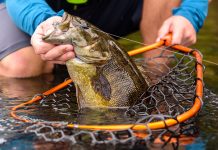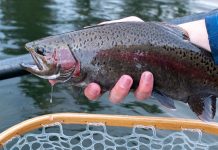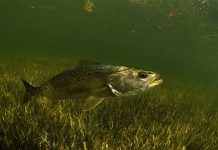My fishing buddy and I were at a local lake in New Jersey on one of those early spring mornings when the bite seems hard to trigger. My friend reached into his tackle box and pulled out a bait I had never used before—a chatterbait. My first thought was, “Is that jig or a spinnerbait? No way a fish will eat this crazy thing.” But, as I watched fish after fish strike the strange lure I soon wanted to learn how to fish a chatterbait too.
If you share a hankering to learn all about chatterbait, read on for our comprehensive guide. We outline the different ways to retrieve a chatterbait to trigger explosive strikes, plus the importance of adding a trailer to the bait. Learn how to choose the right trailer for the conditions you’re fishing in, and which tactics work in which season. Chatterbaits work all year-round, so they should be a staple in every angler’s arsenal.
How Does Chatterbait Work?
On your first cast with a chatterbait you can feel the difference between it and the spinnerbait you might typically use. As you retrieve the chatterbait you can feel its vibration emanating right up the line and into the rod. Look into the water and you’ll notice the flash that its blades give off and how the skirt makes it look like a bait fish scurrying through the water.
Chatterbait has not only the characteristics of a spinnerbait and jig, but also the vibration of a crankbait. This is like a frankenbait—a blend of three baits every angler throws. It totally makes sense to me why the fish will hammer this bait—they simply cannot resist it.
History of Chatterbaits
According to Glenn Young, national sales director for Z-Man Fishing, manufacturers of the original ChatterBaits, the lures got their name when inventor Ronny Davis and son Ron were testing prototypes back in 2003. “Ronny remarked they should call it a ChatterBait because it vibrated so hard it almost made his teeth chatter,” Young says. The Davis’ lure gained such notoriety they couldn’t keep up with orders and sold the manufacturing rights to Z-Man.
The bladed jig’s popularity continues to grow. “Although the ChatterBait is protected by multiple patents, we’ve seen a huge increase in copycats,” Young says. He also noted the lure has proven popular with redfish and calico bass. Everywhere bladed jigs hit the water they are finding success with aggressive fish.
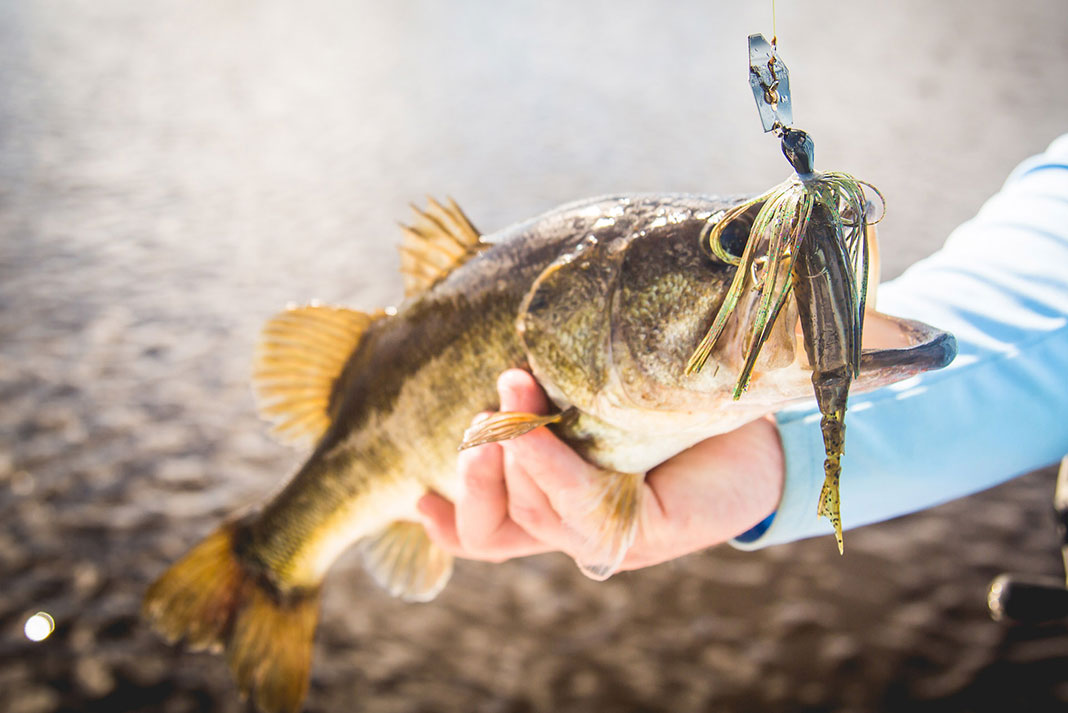
Tournament Fishing with a Chatterbait
Over the years, chatterbait has gained popularity with tournament professionals and weekend warriors. Now, a long list of tournament wins is attributed to this wild-looking reaction bait.
With help from pros like Luke Clausen, Davin Walker and Stephen Browning, chatterbaits have helped many anglers get in the money as a stable bait to throw on the tournament trail. Because of their three-in-one features, chatterbaits are extremely versatile and can be fished in a bunch of different ways and in different seasons.
Last spring, a 3/8-ounce Z-Man ChatterBait Jack Hammer earned Texan Dwayne Taff a $100,000 win in the 2018 Kayak Bass Fishing National Championship. Taff says he tied on the $16 lure because “I wanted to see what the hype was about.” After cashing his big check, he could buy 6,250 Jack Hammers.
Truth is, he switched to the bladed swimbait after pre-fishing produced no keepers. Tournament anglers call this prospecting, making hundreds of long casts to find where bass are holding.
Essential Chatterbait Gear
Favorite Chatterbait:
Z-Man Chatterbait EliteRod:
Quantum Smoke Pt Rod
7 foot MediumReel:
Quantum Speed Freak
Casting Reel 8.1:1Line:
Gamma 10 lb test
copolymer lineKnot:
Palomar
How to Fish a Chatterbait
When bass get lockjaw and Dwayne Taff knows they are still in the area, he lets the bladed jig bounce along the bottom. “I let the jig sink to the bottom then pull it sharply up to give it a quick, hard vibration before letting it sink again.” The bladed jig produces a reaction bites; the flash and noise anger aggressive bass into attack mode.
The tactic saves anglers time by serving as a jig and crankbait in one. Changing the retrieve allows the angler to change tactics without changing lures. The blade makes the lure weedless and snag-resistant too.
“I let the jig sink to the bottom then pull it
sharply up to give it a quick, hard vibration
before letting it sink again.”
Taff’s green-pumpkin colored, 3/8-ounce jig and dark green blade was paired with a Yamamoto Zako trailer. Depending on the local forage, Taff changes the trailer from a paddle tail to imitate baitfish to a twin-tail soft plastic to mimic a crayfish.
Taff says blade color can be a critical consideration. When he wants the vibration without the flash, such as early season, stained water, he will use fingernail polish or a permanent marker to add color to the metal blade.
Best Weather for Chatterbait Fishing
Chicago-based tournament basser, Dustin Murguia uses heavy bladed jigs, up to an ounce, in deep lakes. “I use a bladed jig heavy enough to stay in close contact with grass on the bottom,” he says. Murguia won two of the six contests on the Michigan Kayak Trail Tournament in 2017 working a bladed jig along the bottom.
Murguia admits every day is not a bladed swim jig day. “My best catches come when the sky is overcast and wind roughs the water surface,” he says.
Many anglers throw bladed jigs with heavy-action baitcasters and braided line, but both Taff and Murguia prefer fluorocarbon line and lighter-action rods. Fluorocarbon has more stretch than braid but less than monofilament. The light rod improves the bladed jig’s action.
“My best catches come when the sky is overcast
and wind roughs the water surface.”
“Since braid doesn’t stretch there is a danger of pulling the lure too fast without giving the bass a chance to catch it.” Murguia says. He prefers a seven-foot, medium-action rod with 15-pound fluorocarbon. “When I tear the lure out of grass, the lure pops free and slows down.” He gets many bites on the brief pause.
Chatterbait Fishing in Every Season
Winter Chatterbait Fishing
The cold water period can be a tricky bite to trigger with water temperatures getting lower than 50 degrees. The fish are no longer in their shallow water haunts and now have moved into deeper sections of the body of water. Most anglers have put their tackle boxes and rods away for a long winter nap, but if you brave the cold weather you can still catch fish in these conditions.
The number one rule in the winter is to look for your schools of baitfish. If you find the baitfish, you will find fish. The lake I like to fish in the winter, as long as it hasn’t iced up, has the maximum depth of 12 feet. When the fish get into their winter patterns, I’ll find the baitfish and fish in the six to 9 feet range. I lock onto offshore points that have structure, meaning weeds, rocks and sunken timber. It’s key to focus on dramatic depth changes that would give the fish ways to ambush pray. In the winter, at times it seems you have to put the bait right in front of the fish to entice a strike.
I will rig a white and silver 3/8 chatterbait with a swimbait trailer that complements the colors in the bait. If your bait is white and silver, your swimbait should match it. The trailer is going to give your bait a larger profile and give the fish a larger object to lock onto. I find that a three- to four-inch trailer works very well in the winter.
When I fish the chatterbait I like to retrieve it more like a jig and get a vertical presentation out of it. I will cast it out and let it fall to the bottom. When the bait is falling through the water columns it will have a fluttering drop and you will notice that when you begin to retrieve the bait you sometimes will get a strike right off the bottom.
The important thing to remember is to lift your rod tip as you bring the bait back to the boat. Let the bait rise and fall to the bottom. If there is structure present, let the bait hit into it and lay on the bottom a few seconds longer. By keeping the bait vertical you will be bouncing it off the bottom and coaxing the strike. It will also stay in the strike zone longer than if you brought it back in a steady retrieve. I can’t tell you how many fish I catch in the winter jigging a chatterbait. It has become a favorite bait of mine to use in cold water conditions.
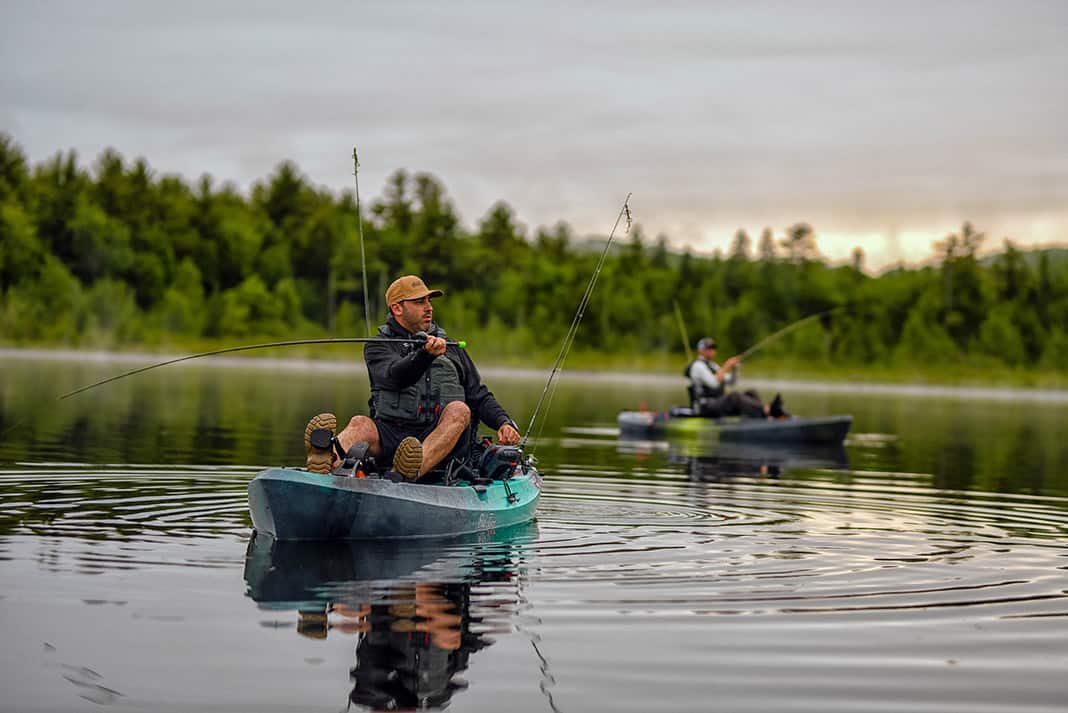
Spring Chatterbait Fishing
When the water begins to warm and the fish start to thaw out from a long winter’s nap, the chatterbait shines. It’s a great bait for every season, but the spring seems to trigger explosive strikes that will make your heart skip a few beats! I like to look for sections on the body of water where shallow flats drop off into deeper water.
These are places the fish will gravitate toward as the waters begin to warm. Also, sections that have rock and wood will hold warmth from the sun’s rays and attract fish. If you have any rivers or streams coming into the water, those would be ideal locations to target. Then, as the fish move shallow to get into the spawning cycle, the chatterbait frenzy will reach monumental proportions.
I like to fish the chatterbait in a slow roll retrieve, letting it swim right over the bottom. As well, when bringing it back to the boat, give it a few jerks and let it fall to the bottom. Then repeat the retrieve and pay close attention the vibration emanating from the bait. If you feel the vibration become weak, you probably have weeds stuck on the bait and it just needs a quick pop to get free of the vegetation. Pay close attention to the shallow water when the fish move shallow. I have gotten some of my best strikes right off the shoreline. If you don’t have a fish finder, one of the best indications is the presence of sunfish—when you see them in the shallow water, the bass are always near.
This brings me to my color selection and how I like to match the hatch. Sunfish, crawfish and perch are the main course this time of the year, and I want my bait to reflect the natural prey fish color. I will choose perch, sunfish, green pumpkin, watermelon and motor oil color patterns. The 3/8-ounce size is my go-to, but sometimes I find the smaller 1/4 size works better in the spring. It has a slimmer profile and falls slower in the water column. The combination of a steady slow roll retrieve and getting shallow will put some spring in your step as you have successful days on the water.
Summer Chatterbait Fishing
In summer, I like to implement the power fishing technique with my chatterbait. I want to cover water quickly and fish as much of the location as possible. The chatterbait gives me everything I need to coax that summer bite. It is an outstanding bait to fish at night because it gives off a high and intense vibration.
This bait screams to the fish, “I’m here, eat me!” You will really get the trophy fish to strike if you throw it at night. When sight is limited, the vibration of this bait sends fish over the edge. The strikes on summer nights using the chatterbait have gotten me out of bed at 4:00 a.m. to get those big old fish.
Using a mental grid, make clockwise casts and cover the water with the bait. In the summer, I’ll let the fish tell me how they want the bait presented. If you notice you’re getting strikes but the fish are not getting hooked, I’ll shorten the trailer. If that does not work, I’ll fish the chatterbait without a trailer until I begin to hook up with the fish.
In the summer, you’ll find the effectiveness of the retrieves depends on the mood of the fish—a faster retrieve works when the fish are more aggressive, while a slower retrieve will get them to bite when they are inactive. If the water you’re fishing has vegetation, make sure to make casts in and around it. The green, healthy weeds will hold the majority of the fish in the summer because they produce increased levels of oxygen. When you run your chatterbait through them, you’re mimicking prey moving through the weeds and the fish will attack out of their predatory instinct. Make sure you have a chatterbait rigged up as one of your baits to entice that summer strike!
Fall Chatterbait Fishing
In the fall, you will find the summer patterns will begin to fade out and where you caught those fish only a few weeks ago will begin to change. The fall changeover is going to affect the fish and the thermocline plays a major role in fish activity. The effects of the fall changeover can last a few weeks and make fishing in the fall tough. Anglers will throw swimbaits, crankbaits and jigs and try to have success.
Just like in the spring, I feel that the fall chatterbait bite is strong and effective. You have the three-in-one feature. You can bump it along the bottom and fish it like a crankbait or swim it through the mid-water column like a swimbait, not to mention the flash the blade will give off. The fall really seems to be a fantastic time of year to fish bladed baits. When the fish are suspended, jigging the chatterbait will work very well.
If the vertical presentation does not seem to do the job, switch over to a slower, steady presentation for success. In the fall, you can use a mixture of all the different ways to retrieve the bait. I also like bringing it back to the boat and fishing it like a jerkbait; it usually produces good results. There’s something about the quick popping of the bait and the slow flutter that drives the fish crazy. You will also find you will get a higher quality bite this time of the year and the fish will be pretty hefty. Make sure you have a chatterbait rigged up because fall is the time for the fish to be feeding up and your chatterbait is the main course.
Try Chatterbait Fishing for Yourself
My love for the chatterbait runs deep and it has produced for me time and time again. It has caught me fish when other baits seemed to stop producing and the fish turned off. It truly is one of the most versatile baits on the market and has a way of preventing the fish from having lockjaw. From its hex-shaped blade to its swim jig-like body to its crankbait wobble, it fishes like a spinnerbait on steroids! It’s no wonder it has gained so much popularity among anglers.
This bait works in all seasons and should be a staple in every angler’s arsenal. | Feature photo courtesy: Old Town Canoes and Kayaks


